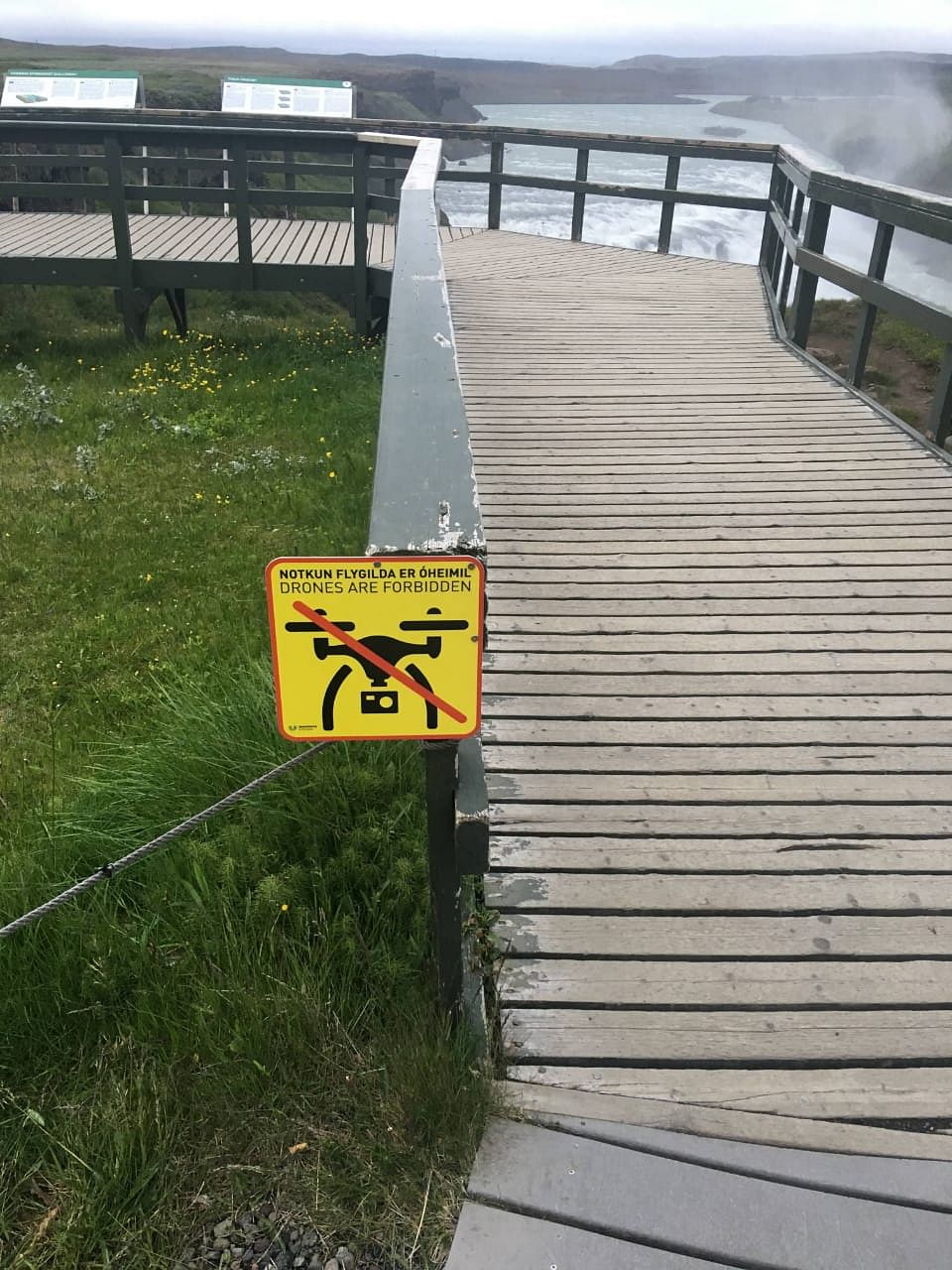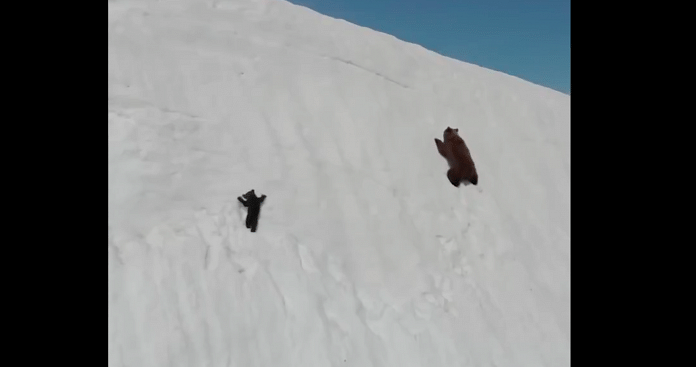The video of a cub struggling to climb a steep icy slope to get to its mother has stoked a debate about the use of drones to record wildlife.
Bengaluru: Over the weekend, a Twitter user posted footage of a mama bear and baby bear climbing up steep icy slopes. The engrossing video shows the baby bear slipping down the icy slopes and clambering up tenaciously to get back to its mother. It has been shared widely and virally, most people admiring the little animal’s persistence.
We could all learn a lesson from this baby bear: Look up & don’t give up. pic.twitter.com/nm0McSYeqY
— IM????HIM (@ziyatong) November 3, 2018
Upon closer examination, though, something stands out. At one point in the video, during a close shot, the mother looks at the drone and inexplicably takes a swipe at the cub, sending it tumbling back down the slopes again as the drone recedes. The fall almost plunges the little bear to its death.
While the video was shared widely as being inspirational and positive, several wildlife conservationists thought differently. Bear experts and zoologists tweeted out their criticism of the video, citing harassment of the animals by drones.
As a #grizzlybear scientist and a drone operator, this is a hard no. This is harassment and put these bears in a real tough situation as they tried to flee. https://t.co/jobtLWZljG
— Clayton T. Lamb (@ClaytonTLamb) November 4, 2018
The video going around of a bear cub scrambling up a snowy cliff to get back to its distressed mother is being shared as a heartwarming metaphor for persistence. It’s not. It’s a dangerous stunt by an irresponsible drone operator who should know better.
— Dr. Jacquelyn Gill (@JacquelynGill) November 4, 2018
While several drone operators jumped to the camera’s defence, several others pointed out online that the drone was indeed too close for comfort. Clayton Lamb, a researcher who studies grizzly bears at the University of Alberta, Canada, and a drone operator, told The Atlantic that it was obvious from the bear’s behaviour that the drone was too close to them.
He said the mother bear clearly pushed the baby down in an effort to protect the little one from the loud drone that was hovering over them.
Different types of drones evoke different responses from animals.
One of the worries with larger fixed-wing drones, is the silhouette and higher survey altitude make the drone resemble large raptors. Which is obviously a concern for species that would show avoidance behaviour towards such predators.
— Andrew Barnas (@AndrewBarnas) November 5, 2018
Larger drones that can climb high up and have a fixed, non-rotating wing tend to resemble predatory raptors like hawks and eagles. Such drones are an immediate concern for animals like hares or the young of any species, which would tend to avoid hunter birds.
Smaller, rotor-blade drones are great for easy manoeuvrability, changing flight patterns at will. This kind of unpredictable flying causes stress to any animal that can see the drone. Furthermore, the rotor-blade drones use motors that cause a loud whirring noise, which is unfamiliar and frightening to most animals.
Lamb told The Atlantic that the entire setting of the video was unnatural, and that the mother bear would never even have taken the cub out on such precarious slopes unless she thought there was a risk to their lives.
This isn’t the first time the irresponsible use of a drone for wildlife has come under attack from biologists or authorities.
In 2014, a drone chased and scattered a herd of Bighorn sheep in Zion National Park, US, prompting authorities to ban the use of the aircraft in the park. Drones have also harassed seals who were on a “protective haul” in Scotland.
VIDEO: Experts are warning that too many drones are disturbing Scotland’s wildlife and users potentially committing a criminal offence. So, how close is too close? (Tip: Watch to the end) https://t.co/rUsXErZhDv @nature_scot @PAWScotland @RSPBScotland @ukwildlifecrime pic.twitter.com/As9vIxZfiz
— Kevin Keane (@KKeaneBBC) August 31, 2018
Drone-animal conflict
There are countless videos on YouTube that show unpleasant drone-animal conflict. Drones have aggravated rams, annoyed a chimpanzee who knocked one down, and have made protective mother kangaroos angry.
Even in familiar settings, animals are spooked by drones, like this cheetah. There are also innumerable videos of birds attacking drones or chasing them confused.
Studies have shown consistently that animals are affected adversely by drones that fly too close, that birds are affected by the angles at which drones fly, penguins in Antarctica tend to be more careful and measured around UAVs, black bears showed increased heart rate by up to 400 per cent in a minute around drones, and elephants start to attack drones when they see one.
Vidoes of drone-animal conflict abound and are constantly recorded and published for entertainment purposes.
Authorities are not unaware of the drone menace. Several places have banned the use of drones.
In India, permits are required to fly drones, which first need to be registered with a unique number from the Directorate General of Civil Aviation.
Drones are always required to be in the line of sight of anyone flying them. This rule holds true for most places. The US has banned the use of drones above water bodies to protect marine life. Drones are also banned in national parks across the world.

This is not to say drones are all bad. They have given us some of the best footage we’ve seen of animals so far, transformed how we see wildlife documentaries, and been a tremendous help to researchers and ecologists studying a region.
But their use must accompany restrictions and guidelines that allow for safe use without harming animals.
Ecologists Jarrod Hodgson and Lian Pin Koh at the University of Adelaide, Australia, came up with a set of guidelines for the responsible use of drones around wildlife in 2016.
These include not flying a drone when the prospective reaction of an animal is unknown, maintaining a safe distance from animals, ceasing drone activity when an animal appears bothered, and publishing exactly how the drone was used in studies.







Can we not leave them alone at least now after we have already caused enough irreparable damage to mother earth and it’s inhabitants. We do not need to probe and exploit and harm them anymore in the name of ‘science’. Just leave them be and they will manage naturally as they always have. Please let them have their life and space back. If we do not exploit and destroy their habitats anymore then we do not really need those ‘scientific’ ways to conserve them. Let them and theirs be at peace.
The video shared widely on WhatsApp was mesmerising and prompted conclusions about how non-human mothers train their offspring. However, thanks for exposing the ugly side of creating wildlife documentaries. Hope some day a fierce debate on animal consent would also take place.